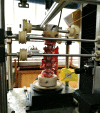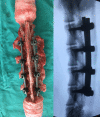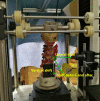Biomechanical Effects of Fixation of Different Segments of Goat Lumbar Spine on Adjacent Segmental Motion and Intradiscal Pressure Change
- PMID: 31260437
- PMCID: PMC6615077
- DOI: 10.12659/MSM.915458
Biomechanical Effects of Fixation of Different Segments of Goat Lumbar Spine on Adjacent Segmental Motion and Intradiscal Pressure Change
Abstract
BACKGROUND The aim of this study was to investigate the biomechanical fixation effects of different segments of the goat spine on adjacent segmental motion and intradiscal pressure (IDP) change. MATERIAL AND METHODS Eighteen goat spine specimens were randomly divided into 3 groups: group A (single-segment fixation), group B (double-segment fixation), and group C (triple-segment fixation). The motion was tested on each specimen using a spinal motion simulation test system with rational pressure loading. The IDP was measured using a pinhole pressure sensor. RESULTS Range of motion (ROM) and IDP of adjacent segments increased with increased external load. In comparison of the 3 groups, significant differences in ROM were found when the external force was more than 100 N (P<0.05). The differences in IDP of the adjacent segment were statistically significant (P<0.05) when external pressure was greater than or equal to 60 N. However, in comparison of group A with group B, no significant differences in ROM and IDP of the adjacent segments were noted for the motions of anterior flexion, posterior extension, and lateral bending (P>0.05). Moreover, upper adjacent segments had greater ROM than the lower adjacent segments (P<0.05). We found significant differences between IDPs of the upper adjacent segments and lower adjacent segments (P<0.05). CONCLUSIONS As the number of fixated lumbar segments increases, ROM and IDP of the adjacent segments increase. Multisegment fixation is most likely the main factor contributing to the development of adjacent segmental lesions after lumbar fixation.
Conflict of interest statement
None.
Figures





Similar articles
-
Upper and lower adjacent segment range of motion after fixation of different lumbar spine segments in the goat: an in vitro experiment.J Int Med Res. 2021 Jun;49(6):3000605211020219. doi: 10.1177/03000605211020219. J Int Med Res. 2021. PMID: 34176345 Free PMC article.
-
Biomechanical comparison of single-level posterior versus transforaminal lumbar interbody fusions with bilateral pedicle screw fixation: segmental stability and the effects on adjacent motion segments.J Neurosurg Spine. 2010 Jun;12(6):700-8. doi: 10.3171/2009.12.SPINE09123. J Neurosurg Spine. 2010. PMID: 20515358
-
Effect of multilevel lumbar disc arthroplasty on the operative- and adjacent-level kinematics and intradiscal pressures: an in vitro human cadaveric assessment.Spine J. 2008 Nov-Dec;8(6):918-25. doi: 10.1016/j.spinee.2007.10.034. Epub 2008 Jan 7. Spine J. 2008. PMID: 18178528
-
In Silico Meta-Analysis of Boundary Conditions for Experimental Tests on the Lumbar Spine.Ann Biomed Eng. 2022 Oct;50(10):1243-1254. doi: 10.1007/s10439-022-03015-x. Epub 2022 Jul 29. Ann Biomed Eng. 2022. PMID: 35904702 Free PMC article. Review.
-
Biomechanics of interspinous devices.Biomed Res Int. 2014;2014:839325. doi: 10.1155/2014/839325. Epub 2014 Jul 9. Biomed Res Int. 2014. PMID: 25114923 Free PMC article. Review.
Cited by
-
Incidence and risk factors of new-onset sacroiliac joint pain after spinal surgery: a systematic review and meta-analysis.PeerJ. 2024 Sep 26;12:e18083. doi: 10.7717/peerj.18083. eCollection 2024. PeerJ. 2024. PMID: 39346039 Free PMC article.
-
Upper and lower adjacent segment range of motion after fixation of different lumbar spine segments in the goat: an in vitro experiment.J Int Med Res. 2021 Jun;49(6):3000605211020219. doi: 10.1177/03000605211020219. J Int Med Res. 2021. PMID: 34176345 Free PMC article.
-
In Vitro Studies for Investigating Creep of Intervertebral Discs under Axial Compression: A Review of Testing Environment and Results.Materials (Basel). 2022 Mar 28;15(7):2500. doi: 10.3390/ma15072500. Materials (Basel). 2022. PMID: 35407833 Free PMC article. Review.
-
Restoration of physiologic loading after engineered disc implantation mitigates immobilization-induced facet joint and paraspinal muscle degeneration.Acta Biomater. 2025 Jan 15;192:128-139. doi: 10.1016/j.actbio.2024.12.014. Epub 2024 Dec 9. Acta Biomater. 2025. PMID: 39653318
-
Biomechanical Effects of Different Prosthesis Types and Fixation Ranges in Multisegmental Total En Bloc Spondylectomy: A Finite Element Study.Orthop Surg. 2024 Oct;16(10):2488-2498. doi: 10.1111/os.14171. Epub 2024 Aug 5. Orthop Surg. 2024. PMID: 39101231 Free PMC article.
References
-
- Willems PC, Staal JB, Walenkamp GH, et al. Spinal fusion for chronic low back pain: Systematic review on the accuracy of tests for patient selection. Spine J. 2013;13(2):99–109. - PubMed
-
- Radcliff KE, Kepler CK, Jakoi A, et al. Adjacent segment disease in the lumbar spine following different treatment interventions. Spine J. 2013;13(10):1339–49. - PubMed
-
- Heo Y, Park JH, Seong HY, et al. Symptomatic adjacent segment degeneration at the L3–4 level after fusion surgery at the L4–5 level: Evaluation of the risk factors and 10-year incidence. Eur Spine J. 2015;24(11):2474–80. - PubMed
-
- Lu K, Liliang PC, Wang HK, et al. Reduction in adjacent-segment degeneration after multilevel posterior lumbar interbody fusion with proximal DIAM implantation. J Neurosurg Spine. 2015;23(2):190–96. - PubMed
-
- Wilke HJ, Kettler A, Claes LE. Are sheep spines a valid biomechanical model for human spines? Spine (Phila Pa 1976) 1997;22(20):2365–74. - PubMed
MeSH terms
LinkOut - more resources
Full Text Sources
Research Materials

